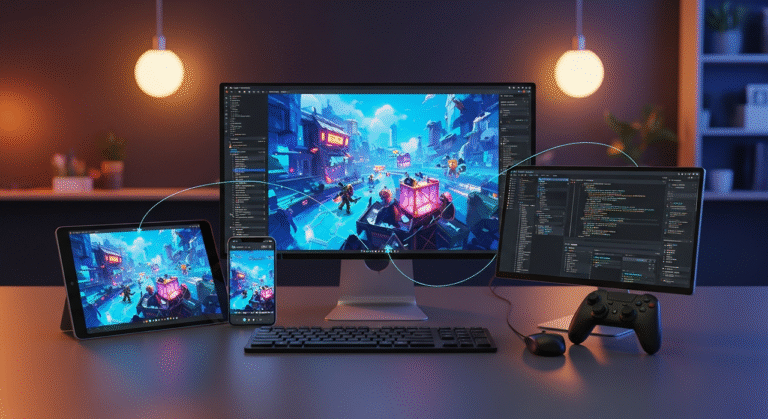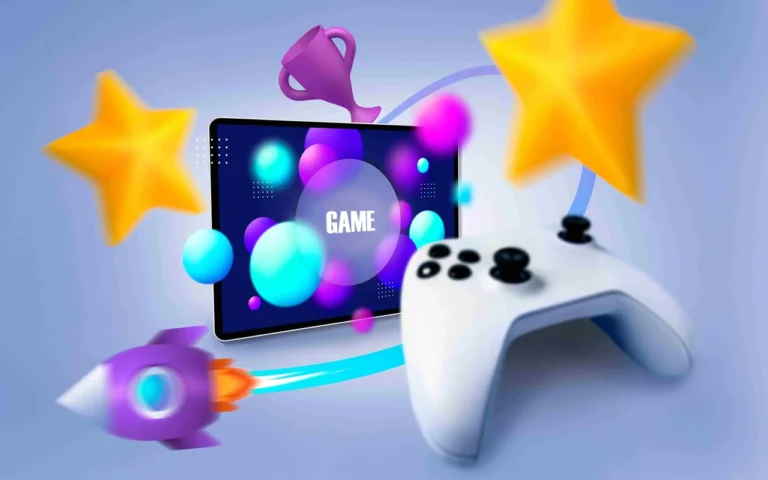Game design is the process of designing the rules, mechanics, visuals, and the content of a video game. It defines how a game will be played, how players interact with it, how it should look. It gives the game identity and defines what exactly the final product is. These crucial design decisions are taken by game designers. They are the brains behind the creation of games. Let’s dive into their world and explore what they do. Here is the list of 8 different types of game designers:
- Lead Game Designer
- Level Designer
- Gameplay Designer
- Game System Designer
- Game Narrative Designer
- Technical Game Designer
- Game UI/UX Designer
- Game Monetization Designer


Need Game Art Services?
Visit our Game Art Service page to see how we can help bring your ideas to life!
Who is a Game Designer?
Games are complicated multifaceted systems consisting of various parts and subsystems. Based on the complexity of a game idea, different designers with various skill sets are needed to bring it to life. In game design process, some game designers work on the visual aspects of the game, while others design systems, mechanics, and the game economy. In this part, we will explore various types of game designers and how they contribute to developing games.

8 Types of Game Desingers
1. Lead Game Designer
A lead game designer, as the name suggests, leads the design efforts for specific parts or an entire game project.
In small game studios, a lead game designer is usually responsible for the entire design for a game, from designing the core game idea to deciding on the visual style. They assign individual artists and developers to various parts of the game and manage them.
In larger game studios, lead game designers are usually responsible for designing a major part of a game, and they usually report to a creative director. A large game project might have multiple lead game designers, each responsible for handling the development of a major feature by managing a group of people.
2. Level Designer
Level designers are responsible for designing game environments and maps. Their job is to understand core game design and create environments that match that design. Level design is a crucial aspect in game design.Level design is not just about how a game looks, It involves carefully studying how a player character is supposed to move around in the game world and interact with it and design the environment accordingly.
3. Gameplay Designer
Gameplay designers design the gameplay and mechanics for a game. They work closely with lead game designers and system designers to create the desired gameplay and manage the creation of game prototypes. They optimize game functionalities like movements, combat, interactions, and AI behaviors.They are responsible for tweaking game mechanics to create a fun and engaging gameplay. They iteratively polish player interactions to create a satisfying gameplay experience.
4. Game System Designer
Game system designers define the underlying rules and systems that define and govern a game. They are responsible for designing core systems that a game relies on, such as progression systems, game difficulty systems, health systems, level ups, crafting, and so on. They define the blueprints according to which various game functionalities should be implemented. Game system designers also oversee the proper implementation of functionalities designed by gameplay designers.
5. Game Narrative Designer
Narrative designers are the brains behind everything story-related in a game. They design the game world, characters, and the settings of a game. They tell the game’s story through designing dialogues and choices that players make. They are like novel authors that create imaginary worlds and fill it with various characters and locations, but they do it in the context of a game. They create game narratives for characters in a game and make them fit in the plot.
6. Technical Game Designer
Technical designers bridge the gap between game design and technical implementation. They are responsible for translating game design into feasible actions that can be implemented by programmers. They should have a deep understanding of both game design principles and technical knowledge involved in creating games. Technical Game designers have responsibilities similar to gameplay designers and system designers. They often use visual programming systems to convert designs into pseudo code or prototypes that facilitate development for programmers.
7. Game UI/UX Designer
A game UI/UX designer is responsible for creating user interfaces inside a game. They design everything UI-related in. Game UI Design includes menus, loading screens, splash screens, buttons, settings sliders and menus, pop-up message windows, shop items, etc. A UI/UX designer also overlooks transitions between game states to ensure annoying situations don’t occur. They pay close attention to how games start and pause, how they prompt players to do certain tasks and try to create a pleasant experience for the user when interacting with the game.
Read More: Game Art vs. Game Design
8. Game Monetization Designer
Game monetization designers design the economy system for a game. They are responsible for creating revenue generation strategies. They decide whether the game should be a paid game or a free one with paid premium features. They decide whether it should include in-app purchases and advertisements and which one bothers players the least. Game monetization decisions are very tricky and they require a thorough study of players’ habits and how they spend money on games.
What Skills Are Needed for Different Game Designers?
Skills required to become a game designer vary according to the type of designer you wish to become. There are various skills we can list for each type of game designer, which would make the article quite lengthy. Thus, we will cover some of the most important ones for each discipline.
-Lead game designers need to have a complete understanding of game patterns and mechanics. Having a strong command of game engines is essential for them. Communication, leadership and project management skills are also crucial. Being creative and having a working knowledge of how to create art is really helpful as well.
-Level designers need to be proficient in game engines like Unity and Unreal Engine. The ability to create 3D art in programs like Blender and Maya is also essential. Having drawing skills is not necessary for a level designer, but they help in creating sketches and rough designs for levels. Knowledge of image editing software like Photoshop is also useful for creating textures used for environments. Basic knowledge of architecture and lighting is also extremely helpful when designing game levels.
-Gameplay designers should be avid gamers. They should be eager to analyze game mechanics and willing to tweak them repeatedly to achieve the desired result. Understanding how different game functionalities work and being able to apply minor tweaks in the code is very useful for a gameplay designer. Although designers are not expected to be skilled programmers, having the ability to read code in C# and C++ is very useful for a gameplay designer.
-Game systems designers should have a deep understanding of various systems and functionalities used in games. They should be familiar with game engines at a more technical level. Programming knowledge of C# and C++ is necessary. Good logic and math skills are required for game system designers.
-Game narrative designers should be good writers. They need to know how to develop characters, create plots and more importantly how to tell stories. Creativity is probably the most important trait of a narrative designer.
-Game technical designers need to have both game design skills and technical skills. Familiarity with game engines and programming skills is necessary. Communication and problem-solving skills are also essential for technical game designers.
-UI/UX designers should have art and 2D design skills. Proficiency in design programs like Photoshop and Illustrator is essential for UI/UX designers. The ability to work with game engines and create user interfaces for games is also necessary.
-Game monetization designers should possess a good understanding of player psychology and game economics. Being able to conduct market research and working with analytics tools are crucial in game monetization. Social engineering and understanding how each type of player spends money on games is also required.
Final Words
Game design is an exciting field that attracts people with various backgrounds. If you enjoy designing things and always wonder how your favorite game could be much better if a certain feature was implemented, or if you often think about making your dream game, you might consider pursuing game design as a career. It is a dream career for people who enjoy technical challenges, problem-solving, teamwork and creativity.









